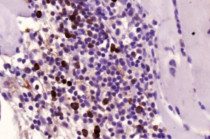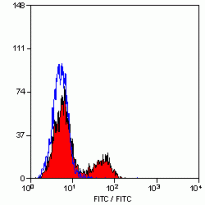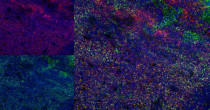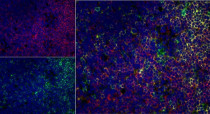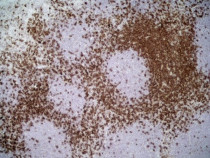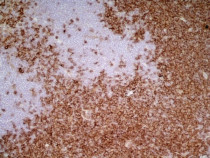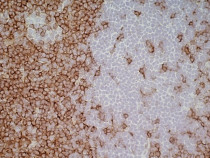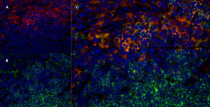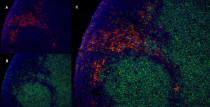ARG22583
anti-CD4 antibody [W3/25]
anti-CD4 antibody [W3/25] for Flow cytometry,IHC-Frozen sections,IHC-Formalin-fixed paraffin-embedded sections and Rat
Developmental Biology antibody; Immune System antibody; Regulatory T cells Study antibody; T-cell infiltration Study antibody; Tumor-infiltrating Lymphocyte Study antibody
Overview
| Product Description | Mouse Monoclonal antibody [W3/25] recognizes CD4 This antibody recognizes the rat CD4 cell surface glycoprotein, a 55kD molecule expressed by helper T cells and weakly by monocytes. This antibody inhibits proliferation and IL-2 production in the MLR reaction.Mouse anti Rat CD4 antibody, clone W3/25 has been described reacting with paraffin-embedded material following PLP fixation (periodate-lysine-paraformaldehyde) (Whiteland et al. 1995).Mouse anti Rat CD4 antibody, clone W3/25 is routinely tested in flow cytometry on rat splenocytes |
|---|---|
| Tested Reactivity | Rat |
| Tested Application | FACS, IHC-Fr, IHC-P |
| Host | Mouse |
| Clonality | Monoclonal |
| Clone | W3/25 |
| Isotype | IgG1 |
| Target Name | CD4 |
| Antigen Species | Rat |
| Immunogen | Rat Thymocyte Membrane Glycoproteins. |
| Conjugation | Un-conjugated |
| Alternate Names | CD4mut; CD antigen CD4; T-cell surface glycoprotein CD4; T-cell surface antigen T4/Leu-3 |
Application Instructions
| Application Suggestion |
|
||||||||
|---|---|---|---|---|---|---|---|---|---|
| Application Note | IHC-P: PLP fixation is recommended for optimal results. Antigen Retrieval: Citrate acid buffer in TBST (pH 6.0), heat in pressure cooker for 5 min. FACS: Use 10ul of the suggested working dilution to label 10^6 cells in 100ul. * The dilutions indicate recommended starting dilutions and the optimal dilutions or concentrations should be determined by the scientist. |
Properties
| Form | Liquid |
|---|---|
| Purification | Purification with Protein A. |
| Buffer | PBS and 0.09% Sodium azide. |
| Preservative | 0.09% Sodium azide |
| Concentration | 1 mg/ml |
| Storage Instruction | For continuous use, store undiluted antibody at 2-8°C for up to a week. For long-term storage, aliquot and store at -20°C or below. Storage in frost free freezers is not recommended. Avoid repeated freeze/thaw cycles. Suggest spin the vial prior to opening. The antibody solution should be gently mixed before use. |
| Note | For laboratory research only, not for drug, diagnostic or other use. |
Bioinformation
| Database Links | |
|---|---|
| Gene Symbol | Cd4 |
| Gene Full Name | Cd4 molecule |
| Background | CD4 is a membrane glycoprotein of T lymphocytes that interacts with major histocompatibility complex class II antigenes and is also a receptor for the human immunodeficiency virus. This gene is expressed not only in T lymphocytes, but also in B cells, macrophages, and granulocytes. It is also expressed in specific regions of the brain. The protein functions to initiate or augment the early phase of T-cell activation, and may function as an important mediator of indirect neuronal damage in infectious and immune-mediated diseases of the central nervous system. Multiple alternatively spliced transcript variants encoding different isoforms have been identified in this gene. [provided by RefSeq, Aug 2010] |
| Function | CD4 is an integral membrane glycoprotein that plays an essential role in the immune response and serves multiple functions in responses against both external and internal offenses. In T-cells, functions primarily as a coreceptor for MHC class II molecule:peptide complex. The antigens presented by class II peptides are derived from extracellular proteins while class I peptides are derived from cytosolic proteins. Interacts simultaneously with the T-cell receptor (TCR) and the MHC class II presented by antigen presenting cells (APCs). In turn, recruits the Src kinase LCK to the vicinity of the TCR-CD3 complex. LCK then initiates different intracellular signaling pathways by phosphorylating various substrates ultimately leading to lymphokine production, motility, adhesion and activation of T-helper cells. In other cells such as macrophages or NK cells, plays a role in differentiation/activation, cytokine expression and cell migration in a TCR/LCK-independent pathway. Participates in the development of T-helper cells in the thymus and triggers the differentiation of monocytes into functional mature macrophages. [UniProt] |
| Highlight | Related products: CD4 antibodies; CD4 ELISA Kits; CD4 Duos / Panels; Anti-Mouse IgG secondary antibodies; Related news: New antibody panels and duos for Tumor immune microenvironment Tumor-Infiltrating Lymphocytes (TILs) |
| Research Area | Developmental Biology antibody; Immune System antibody; Regulatory T cells Study antibody; T-cell infiltration Study antibody; Tumor-infiltrating Lymphocyte Study antibody |
| Calculated MW | 51 kDa |
| PTM | Palmitoylation and association with LCK contribute to the enrichment of CD4 in lipid rafts. |
Images (13) Click the Picture to Zoom In
-
ARG22583 anti-CD4 antibody [W3/25] IHC-Fr image
Immunohistochemistry: Frozen section of Rat spleen stained with ARG22583 anti-CD4 antibody [W3/25].
-
ARG22583 anti-CD4 antibody [W3/25] IHC-P image
Immunohistochemistry: Paraffin-embedded Rat spleen tissue. Antigen Retrieval: Citrate acid buffer in TBST (pH 6.0), heat in pressure cooker for 5 min. The tissue section was stained with ARG22583 anti-CD4 antibody [W3/25] at 1:50 dilution.
-
ARG22583 anti-CD4 antibody [W3/25] FACS image
Flow Cytometry: Stimulated Rat spleen cells stained with ARG22583 anti-CD4 antibody [W3/25].
-
ARG22583 anti-CD4 antibody [W3/25] IHC-Fr image
Immunohistochemistry: Rat lymph node cryosection stained with Mouse anti Rat CD43 antibody in red and ARG22583 anti-CD4 antibody [W3/25] in green. Merged image is on the right. (Low power).
-
ARG22583 anti-CD4 antibody [W3/25] IHC-Fr image
Immunohistochemistry: Rat lymph node cryosection stained with Mouse anti Rat CD43 antibody in red and ARG22583 anti-CD4 antibody [W3/25] in green. Merged image is on the right. (Medium power).
-
ARG22583 anti-CD4 antibody [W3/25] IHC-Fr image
Immunohistochemistry: Rat lymph node cryosection stained with Mouse anti Rat CD43 antibody in red and ARG22583 anti-CD4 antibody [W3/25] in green. Merged image is on the right. (High power).
-
ARG22583 anti-CD4 antibody [W3/25] IHC-Fr image
Immunohistochemistry: Rat lymph node cryosection stained with ARG22583 anti-CD4 antibody [W3/25]. (Low power).
-
ARG22583 anti-CD4 antibody [W3/25] IHC-Fr image
Immunohistochemistry: Rat lymph node cryosection stained with ARG22583 anti-CD4 antibody [W3/25]. (Medium power).
-
ARG22583 anti-CD4 antibody [W3/25] IHC-Fr image
Immunohistochemistry: Rat lymph node cryosection stained with ARG22583 anti-CD4 antibody [W3/25]. (High power).
-
ARG22583 anti-CD4 antibody [W3/25] IHC-Fr image
Immunohistochemistry: Rat lymph node cryosection stained with Mouse anti Rat CD172a antibody, red in A and ARG22583 anti-CD4 antibody [W3/25], green in B. C is the Merged image stained with nuclei counter-stained blue using DAPI. (High power).
-
ARG22583 anti-CD4 antibody [W3/25] IHC-Fr image
Immunohistochemistry: Rat lymph node cryosection stained with Mouse anti Rat CD68 antibody, red in A and ARG22583 anti-CD4 antibody [W3/25], green in B. C is the merged image stained with nuclei counter-stained blue using DAPI. (Medium power).
-
ARG22583 anti-CD4 antibody [W3/25] IHC-Fr image
Immunohistochemistry: Rat lymph node cryosection stained with Mouse anti Rat CD169, clone ED3, red in A and ARG22583 anti-CD4 antibody [W3/25], green in B. C is the merged image stained with nuclei counter-staind blue using DAPI. (High power).
-
ARG22583 anti-CD4 antibody [W3/25] IHC-Fr image
Immunohistochemistry: Rat lymph node cryosection stained with Mouse anti Rat CD169, clone ED3, red in A and ARG22583 anti-CD4 antibody [W3/25], green in B. C is the merged image stained with nuclei counter-staind blue using DAPI. (Low power).

